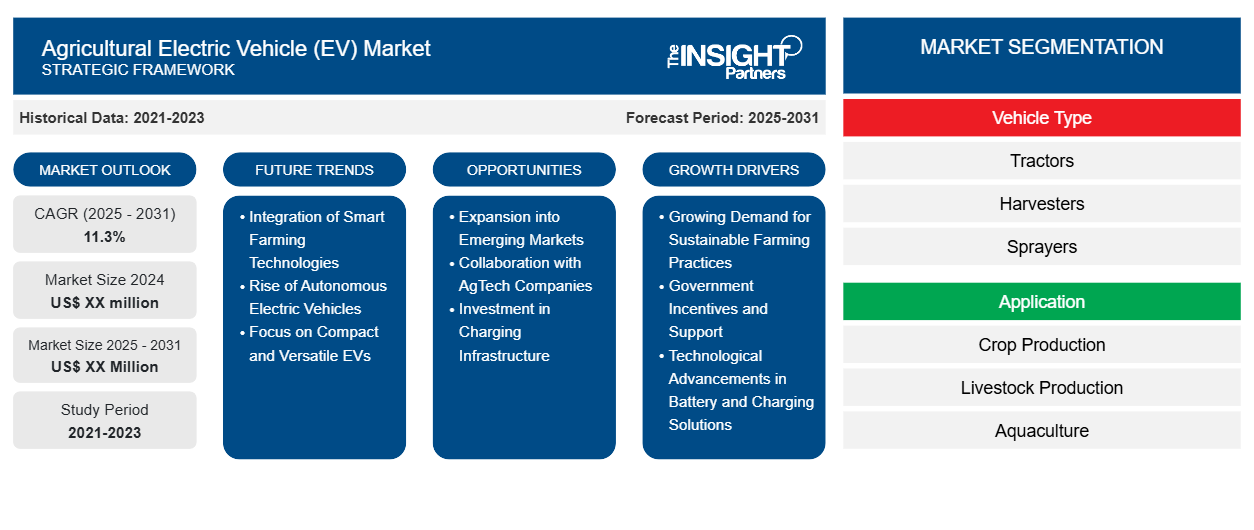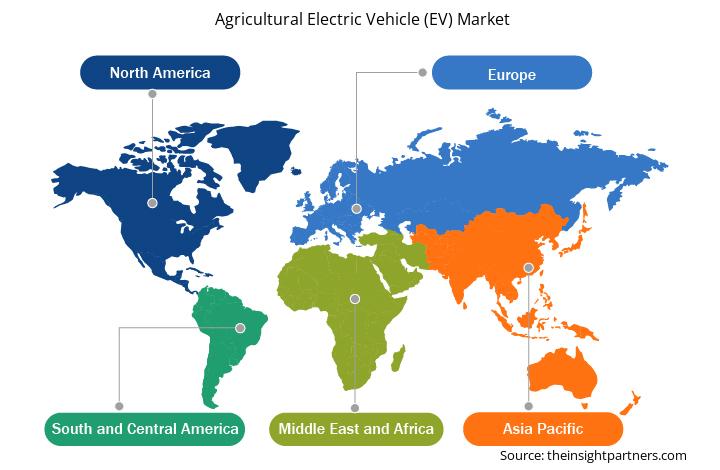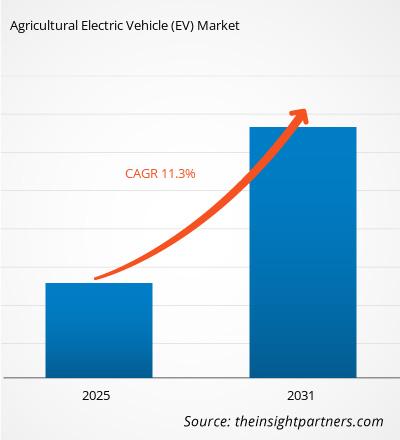من المتوقع أن يسجل سوق المركبات الكهربائية الزراعية معدل نمو سنوي مركب بنسبة 11.3٪ من عام 2025 إلى عام 2031، مع توسع حجم السوق من XX مليون دولار أمريكي في عام 2024 إلى XX مليون دولار أمريكي بحلول عام 2031.
يُقسّم التقرير حسب نوع المركبة (الجرارات، الحصادات، الرشاشات)، والاستخدام (إنتاج المحاصيل، إنتاج الثروة الحيوانية، وتربية الأحياء المائية). ويُفصّل التحليل العالمي بشكل أكبر على المستوى الإقليمي والدولي الرئيسي. ويُقدّم التقرير القيمة بالدولار الأمريكي للتحليل والقطاعات المذكورة أعلاه.
غرض التقرير
يهدف تقرير سوق المركبات الكهربائية الزراعية الصادر عن شركة إنسايت بارتنرز إلى وصف المشهد الحالي والنمو المستقبلي، وأهم العوامل المحفزة، والتحديات، والفرص المتاحة. وسيوفر هذا التقرير رؤى ثاقبة لمختلف أصحاب المصلحة في قطاع الأعمال، مثل:
- مزودي التكنولوجيا/المصنعين: لفهم ديناميكيات السوق المتطورة ومعرفة فرص النمو المحتملة، وتمكينهم من اتخاذ قرارات استراتيجية مستنيرة.
- المستثمرون: إجراء تحليل شامل للاتجاهات فيما يتعلق بمعدل نمو السوق، والتوقعات المالية للسوق، والفرص المتاحة عبر سلسلة القيمة.
- الهيئات التنظيمية: لتنظيم السياسات ومراقبة الأنشطة في السوق بهدف تقليل الانتهاكات والحفاظ على ثقة المستثمرين ودعم سلامة السوق واستقرارها.
تجزئة سوق المركبات الكهربائية الزراعية
نوع المركبة
- الجرارات
- الحصادات
- الرشاشات
طلب
- إنتاج المحاصيل
- إنتاج الثروة الحيوانية
- تربية الأحياء المائية
قم بتخصيص هذا التقرير ليناسب متطلباتك
ستحصل على تخصيص لأي تقرير - مجانًا - بما في ذلك أجزاء من هذا التقرير، أو تحليل على مستوى الدولة، وحزمة بيانات Excel، بالإضافة إلى الاستفادة من العروض والخصومات الرائعة للشركات الناشئة والجامعات
سوق المركبات الكهربائية الزراعية: رؤى استراتيجية

- احصل على أهم اتجاهات السوق الرئيسية لهذا التقرير.ستتضمن هذه العينة المجانية تحليل البيانات، بدءًا من اتجاهات السوق وحتى التقديرات والتوقعات.
عوامل نمو سوق المركبات الكهربائية الزراعية
- تزايد الطلب على ممارسات الزراعة المستدامة:
يتبنى القطاع الزراعي بشكل متزايد ممارسات مستدامة لمعالجة المخاوف البيئية وتقليل البصمة الكربونية. ويعزز هذا التحول الطلب على المركبات الكهربائية، إذ توفر بديلاً أنظف وأكثر كفاءة من الآلات التقليدية التي تعمل بالديزل. ويدرك المزارعون فوائد المركبات الكهربائية في تقليل الانبعاثات، وخفض تكاليف الوقود، وتعزيز الكفاءة التشغيلية. ومع تزايد أولوية الاستدامة، من المتوقع أن ينمو الطلب على المركبات الكهربائية الزراعية بشكل ملحوظ.EVs in reducing emissions, lowering fuel costs, and enhancing operational efficiency. As sustainability becomes a priority, the demand for agricultural electric vehicles is expected to grow significantly. - الحوافز والدعم الحكومي:
تُطبّق حكومات عديدة حول العالم سياساتٍ وتُقدّم حوافز لتشجيع استخدام المركبات الكهربائية، بما في ذلك في القطاع الزراعي. تشمل هذه الحوافز تخفيضاتٍ ضريبيةً ومنحًا ودعمًا لشراء الآلات الزراعية الكهربائية. إضافةً إلى ذلك، تستثمر الحكومات في البنية التحتية لشحن المركبات الكهربائية لدعم اعتمادها في المناطق الريفية. تُسهّل هذه التدابير الداعمة وصول المزارعين إلى المركبات الكهربائية وتجعلها أكثر جدوىً من الناحية المالية، مما يُعزّز نمو السوق.EV adoption in rural areas. Such supportive measures are making electric vehicles more accessible and financially viable for farmers, further propelling market growth. - التطورات التكنولوجية في حلول البطاريات والشحن:
تُحدث التطورات الحديثة في تكنولوجيا البطاريات وحلول الشحن تأثيرًا كبيرًا على سوق المركبات الكهربائية الزراعية. فالتحسينات في سعة البطاريات وكفاءتها وعمرها الافتراضي تُمكّن المركبات الكهربائية من العمل لفترات أطول وقطع مسافات أطول. كما يُتيح تطوير محطات الشحن السريع سرعةً في زمن الشحن، مما يجعل المركبات الكهربائية أكثر عمليةً في العمليات الزراعية. ومع استمرار التقدم التكنولوجي، يزداد الإقبال على المركبات الكهربائية، مما يُشجع على اعتمادها في الممارسات الزراعية.
اتجاهات مستقبل سوق المركبات الكهربائية الزراعية
- دمج تقنيات الزراعة الذكية:
يشهد سوق المركبات الكهربائية الزراعية توجهًا نحو دمج تقنيات الزراعة الذكية. ويتم تجهيز المركبات الكهربائية بشكل متزايد بأجهزة استشعار متطورة، ونظام تحديد المواقع العالمي (GPS)، وتقنيات إنترنت الأشياء لتحسين العمليات الزراعية. يتيح هذا التكامل الزراعة الدقيقة، مما يُمكّن المزارعين من مراقبة المحاصيل وحالة التربة وأداء الآلات آنيًا. ومع تزايد انتشار الزراعة الذكية، من المتوقع أن يزداد الطلب على المركبات الكهربائية التي تدعم هذه التقنيات، مما يُعزز الابتكار في السوق. - صعود المركبات الكهربائية ذاتية القيادة:
من الاتجاهات البارزة الأخرى صعود المركبات الكهربائية ذاتية القيادة في الزراعة. تستطيع هذه الآلات ذاتية القيادة أداء مهام متنوعة، مثل الزراعة والحصاد ومراقبة الحقول، دون تدخل بشري مباشر. إن الجمع بين الطاقة الكهربائية والأتمتة لا يزيد الكفاءة فحسب، بل يقلل أيضًا من تكاليف العمالة. ومع سعي المزارعين إلى إيجاد سبل لتحسين الإنتاجية وتبسيط العمليات، يتزايد الاهتمام بالمركبات الكهربائية ذاتية القيادة، مما يُشكل مستقبل الممارسات الزراعية. - التركيز على المركبات الكهربائية المدمجة ومتعددة الاستخدامات:
يتزايد الطلب على المركبات الكهربائية المدمجة ومتعددة الاستخدامات، القادرة على التنقل في الحقول الصغيرة والعمل في بيئات زراعية متنوعة. يبحث المزارعون عن مركبات صديقة للبيئة، وقادرة أيضًا على أداء مهام متعددة، من النقل إلى العمل الميداني. يدفع هذا التوجه الشركات المصنعة إلى تطوير مركبات كهربائية أصغر حجمًا وأكثر مرونة، تلبي الاحتياجات المتنوعة للزراعة الحديثة، مما يعزز جاذبيتها في السوق.
فرص سوق المركبات الكهربائية الزراعية
- التوسع في الأسواق الناشئة:
تُتيح الأسواق الناشئة فرصًا واعدة لسوق المركبات الكهربائية الزراعية. ومع تسارع وتيرة التحضر والتحديث الزراعي في هذه المناطق، تزداد الحاجة إلى حلول زراعية فعّالة. ويمكن للمركبات الكهربائية أن تلعب دورًا محوريًا في تحسين الإنتاجية مع تقليل الأثر البيئي. ويمكن للشركات التي تدخل هذه الأسواق بشكل استراتيجي الاستفادة من الطلب المتزايد على الممارسات الزراعية المستدامة، مما يُهيئها لتحقيق نمو ونجاح طويل الأمد. - التعاون مع شركات التكنولوجيا الزراعية:
يُتيح التعاون بين مُصنّعي المركبات الكهربائية وشركات التكنولوجيا الزراعية فرصةً فريدةً لتحسين عروض المنتجات. فمن خلال الشراكة مع شركات التكنولوجيا، يُمكن للمُصنّعين دمج حلولٍ مُبتكرة، مثل أدوات الزراعة الدقيقة، وتحليلات البيانات، وأنظمة المراقبة عن بُعد، في مركباتهم الكهربائية. ويمكن أن يُؤدي هذا التعاون إلى تطوير حلول زراعية أكثر تطورًا وكفاءة، تُناسب المزارعين المُلِمّين بالتكنولوجيا والباحثين عن أدواتٍ شاملةٍ لتحسين عملياتهم. - الاستثمار في البنية التحتية للشحن:
يُعدّ تطوير بنية تحتية متينة للشحن فرصةً بالغة الأهمية لسوق المركبات الكهربائية الزراعية. ومع ازدياد عدد المركبات الكهربائية، سيزداد الطلب على محطات شحن موثوقة وسهلة الوصول. ويمكن للشركات والحكومات الاستثمار في إنشاء شبكات شحن مصممة خصيصًا للمناطق الريفية والزراعية، مما يضمن حصول المزارعين على الدعم اللازم لاعتماد المركبات الكهربائية. ويمكن لهذا الاستثمار في البنية التحتية أن يعزز بشكل كبير جدوى المركبات الكهربائية في الزراعة، ويشجع على اعتمادها على نطاق أوسع.
رؤى إقليمية حول سوق المركبات الكهربائية الزراعية
قام محللو إنسايت بارتنرز بشرح شامل للاتجاهات الإقليمية والعوامل المؤثرة في سوق المركبات الكهربائية الزراعية خلال فترة التوقعات. ويناقش هذا القسم أيضًا قطاعات سوق المركبات الكهربائية الزراعية ومناطقها الجغرافية في أمريكا الشمالية، وأوروبا، وآسيا والمحيط الهادئ، والشرق الأوسط وأفريقيا، وأمريكا الجنوبية والوسطى.

- احصل على البيانات الإقليمية المحددة لسوق المركبات الكهربائية الزراعية (EV)
نطاق تقرير سوق المركبات الكهربائية الزراعية
| سمة التقرير | تفاصيل |
|---|---|
| حجم السوق في عام 2024 | XX مليون دولار أمريكي |
| حجم السوق بحلول عام 2031 | XX مليون دولار أمريكي |
| معدل النمو السنوي المركب العالمي (2025 - 2031) | 11.3% |
| البيانات التاريخية | 2021-2023 |
| فترة التنبؤ | 2025-2031 |
| القطاعات المغطاة | حسب نوع السيارة
|
| المناطق والدول المغطاة | أمريكا الشمالية
|
| قادة السوق وملفات تعريف الشركات الرئيسية |
|
كثافة اللاعبين في سوق المركبات الكهربائية الزراعية: فهم تأثيرها على ديناميكيات الأعمال
يشهد سوق المركبات الكهربائية الزراعية نموًا متسارعًا، مدفوعًا بتزايد طلب المستخدمين النهائيين نتيجةً لعوامل مثل تفضيلات المستهلكين المتطورة، والتقدم التكنولوجي، وزيادة الوعي بمزايا المنتج. ومع تزايد الطلب، تعمل الشركات على توسيع عروضها، والابتكار لتلبية احتياجات المستهلكين، والاستفادة من الاتجاهات الناشئة، مما يُعزز نمو السوق.
تشير كثافة اللاعبين في السوق إلى توزيع الشركات العاملة في سوق أو قطاع معين. وتشير إلى عدد المنافسين (اللاعبين في السوق) الموجودين في سوق معين نسبةً إلى حجمه أو قيمته السوقية الإجمالية.
الشركات الرئيسية العاملة في سوق المركبات الكهربائية الزراعية هي:
- ماهيندرا وماهيندرا
- يانمار
- سوليس
- جرار كيوتي
- زوملايون
إخلاء المسؤولية : الشركات المذكورة أعلاه ليست مرتبة بأي ترتيب معين.

- احصل على نظرة عامة على أهم اللاعبين الرئيسيين في سوق المركبات الكهربائية الزراعية (EV)
نقاط البيع الرئيسية
- التغطية الشاملة: يغطي التقرير بشكل شامل تحليل المنتجات والخدمات والأنواع والمستخدمين النهائيين لسوق المركبات الكهربائية الزراعية (EV)، مما يوفر مشهدًا شاملاً.
- تحليل الخبراء: تم تجميع التقرير على أساس الفهم العميق لخبراء الصناعة والمحللين.
- معلومات محدثة: يضمن التقرير أهمية الأعمال التجارية بسبب تغطيته للمعلومات الحديثة واتجاهات البيانات.
- خيارات التخصيص: يمكن تخصيص هذا التقرير لتلبية متطلبات العملاء المحددة وتلبية استراتيجيات العمل بشكل مناسب.
لذا، يُمكن أن يُساعد تقرير البحث حول سوق المركبات الكهربائية الزراعية في تمهيد الطريق لفهم سيناريوهات هذه الصناعة وآفاق نموها. ورغم وجود بعض المخاوف المُبررة، إلا أن فوائد هذا التقرير الإجمالية تفوق عيوبه.
- التحليل التاريخي (سنتان)، سنة الأساس، التوقعات (7 سنوات) مع معدل النمو السنوي المركب
- تحليل PEST و SWOT
- حجم السوق والقيمة / الحجم - عالمي، إقليمي، بلد
- الصناعة والمنافسة
- مجموعة بيانات إكسل
التقارير الحديثة
شهادات العملاء
سبب الشراء
- اتخاذ قرارات مدروسة
- فهم ديناميكيات السوق
- تحليل المنافسة
- رؤى العملاء
- توقعات السوق
- تخفيف المخاطر
- التخطيط الاستراتيجي
- مبررات الاستثمار
- تحديد الأسواق الناشئة
- تحسين استراتيجيات التسويق
- تعزيز الكفاءة التشغيلية
- مواكبة التوجهات التنظيمية




















 احصل على عينة مجانية ل - سوق المركبات الكهربائية الزراعية
احصل على عينة مجانية ل - سوق المركبات الكهربائية الزراعية